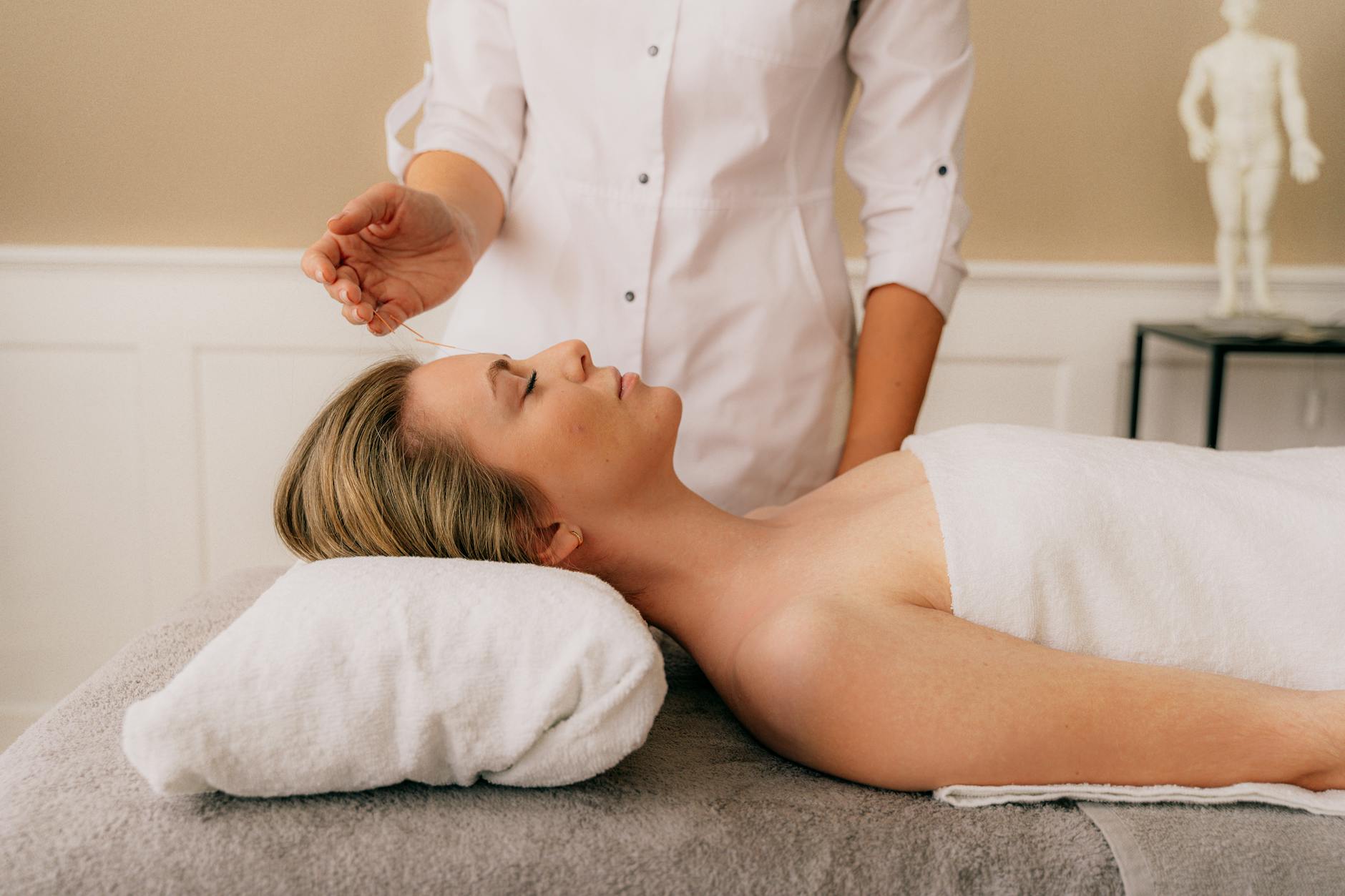How Acupuncture Eases Pelvic Pain Without Drugs
Living with chronic pelvic pain can disrupt your daily life and steal your energy. For many people, prescription drugs are often the go-to fix, but these medications can bring unwanted side effects and may not always provide lasting relief. That’s why more people are turning to holistic choices like acupuncture to break the pain cycle—without relying on drugs.
Acupuncture, rooted in traditional Chinese medicine, is showing promise as a safe way to ease symptoms tied to pelvic pain. From endometriosis to chronic prostatitis or muscle pain in the pelvic region, research points to real, measurable benefits. In this post, you’ll learn how acupuncture works on pain, why it’s gaining popularity, and what to expect if you want a treatment that supports your body—without medicine.
Understanding Pelvic Pain: Causes and Challenges
 Photo by Andrea Piacquadio
Photo by Andrea Piacquadio
Pelvic pain is not just another ache or cramp—it can grip your life in stubborn, surprising ways. From mild discomfort to pain so sharp it stops you in your tracks, this problem often affects people for years. Many folks are left searching for answers, especially when tests and scans come back “normal.” To truly understand why drug-free solutions like acupuncture are catching on, it helps to look at what causes pelvic pain and why finding the right relief can be so frustrating.
Common Causes of Pelvic Pain
A handful of conditions drive most cases of pelvic pain, but they’re not always easy to pin down. Here are some frequent culprits:
- Endometriosis: This condition happens when tissue that acts like the lining of the uterus grows outside it. It may cause intense cramps, stabbing pain, and problems during periods or sex.
- Chronic Pelvic Pain Syndrome (CPPS): Pain lingers in the lower belly or hips for at least six months, with no clear sign of infection or visible cause. Both women and men can develop CPPS.
- Pelvic Floor Dysfunction: The muscles that support the pelvis become too tight, too weak, or don’t work right. This tension can trigger aches, pressure, or shooting pains.
- Other factors: Irritable Bowel Syndrome (IBS), muscle injuries, and nerve problems in the pelvis may also play a role.
Each person’s pain can feel different, making a clear diagnosis tough. Sometimes, more than one cause piles up at once.
How Pelvic Pain Impacts Daily Life
Chronic pelvic pain doesn’t just hurt your body. It also spills over into your work, relationships, sleep, and energy levels. You may find simple tasks like sitting, walking, or driving hard to handle. For many, sex becomes uncomfortable or even off-limits. Some people miss days at work or school, while others pull back from hobbies or social time.
Common effects include:
- Trouble sleeping due to pain flares
- Strained relationships, especially with partners or close friends
- Mood swings, anxiety, or low mood
- Fatigue from the body’s constant stress response
It’s easy to feel frustrated or isolated when others don’t “see” your pain.
Why Drug-Free Solutions Are Gaining Popularity
Standard treatments for pelvic pain often start with prescription pills—painkillers, muscle relaxers, or hormonal drugs. But these medications don’t always hit the root of the problem. Side effects like brain fog, stomach issues, and risk of dependence make many people wary of staying on meds long-term.
That’s why interest in drug-free approaches is on the rise. People want real relief without worrying about more problems down the road. Physical therapy, mindfulness, and acupuncture have moved from “last resort” to “first step” for many who hope to:
- Avoid medication side effects and dependency
- Address the root causes, like muscle tension or nerve hypersensitivity
- Get tailored care that treats the mind and body together
Pelvic pain is complex, but a fresh look at drug-free options is helping many people find relief and get back to living life on their own terms.
How Acupuncture Relieves Pelvic Pain: Mechanisms Explained
Acupuncture’s ability to calm pelvic pain isn’t magic—it’s backed by real, physical changes inside your body. Scientists have studied how gentle needling at specific points can disrupt pain signals, unlock the body’s natural soothing chemicals, and shift the way muscles and blood vessels behave in the pelvic area. At the same time, traditional Chinese medicine brings a different lens, focusing on restoring the flow of qi (energy) through pathways called meridians. Here’s how both modern science and thousands of years of tradition explain why acupuncture works for pelvic pain.
Neurochemical Modulation and Endorphin Release
 Photo by RDNE Stock project
Photo by RDNE Stock project
When an acupuncturist gently inserts needles, it wakes up the nervous system. This triggers a rush of natural chemicals that help block pain and lift mood:
- Endorphins and enkephalins: These are your body’s built-in pain relievers, often called “feel-good” chemicals. Acupuncture helps release more of them in the spinal cord and brain, so pain signals from the pelvis are dialed down before you even notice them.
- Serotonin and dopamine: These mood and comfort chemicals also get a boost, which can help if chronic pelvic pain has left you feeling anxious or down.
- Reduced inflammation: Acupuncture lowers certain chemicals (like prostaglandins and cytokines) that spark and amplify pain, especially in conditions like endometriosis or chronic pelvic pain syndrome.
Here’s what’s going on beneath the surface:
- Stimulation of nerve fibers sends a signal through the spinal cord and up to the brain.
- The brain responds by releasing endorphins, creating a natural “pain off switch.”
- Stress signals drop as your body returns to a calmer state.
This is why many people report feeling looser, more balanced, and even happier after a session.
Blood Circulation and Muscle Relaxation in the Pelvis
Pelvic pain often includes tight, sore muscles and poor circulation, especially in areas that get little movement. Acupuncture works like a “reset button” for this system:
- Better blood flow: Needles prompt tiny blood vessels to open, which brings more oxygen and nutrients to the pelvic region. This helps stressed tissues heal and can reduce swelling.
- Muscle relaxation: Acupuncture interrupts pain cycles by decreasing the activity of overactive nerves and relaxing clenched pelvic floor muscles. This is a huge relief for anyone who feels like they’re “locked up” with tension.
- Local effect at the needle site: The tiny, focused micro-injury of a needle prompts adenosine (an anti-pain molecule) to release at the site, further calming sore tissues.
Put simply, acupuncture helps the pelvis “breathe easier”—less tension, less swelling, and better healing.
Traditional Chinese Medicine Perspective: Balancing Qi
From the perspective of traditional Chinese medicine (TCM), pain means something is blocking or weakening your qi, the vital energy moving through the body’s network of meridians.
- Qi stagnation: When qi doesn’t flow well, it can settle and cause soreness, swelling, or sharp pains in the pelvic area.
- Restoring balance: Acupuncturists select points that target specific meridians linked to pelvic health—like those on the lower abdomen, back, or legs. By stimulating these points, they aim to “unblock” stuck energy and restore smooth flow.
- Holistic support: TCM doesn’t just treat the spot that hurts. It looks for the root cause—stress, digestion, hormone imbalance—and treats the whole person.
For centuries, this focus on balance and flow has made acupuncture a trusted tool for painful conditions. Today, many people find that blending these old ideas with new science gives the best of both worlds—real, lasting relief that reaches deeper than just masking symptoms.
Scientific Evidence: What Research Shows About Acupuncture for Pelvic Pain
Acupuncture has moved from a niche therapy to a well-researched option for people struggling with pelvic pain. In the past decade, studies have poured in—testing its real-world impact not just for generalized pain, but for tough cases like endometriosis and chronic prostatitis. Let’s look at how the latest research stacks up.
Efficacy in Chronic Pelvic Pain and Endometriosis
 Photo by Antoni Shkraba Studio
Photo by Antoni Shkraba Studio
Modern studies point to clear benefits for people with chronic pelvic pain—especially when linked to endometriosis. Over the last few years, several randomized controlled trials and systematic reviews have pooled their results to compare acupuncture to standard drug treatments. Here’s what stands out:
- Pain scores drop noticeably: Meta-analyses consistently show a significant reduction in reported pain after regular acupuncture. A 2023 review found pain dropped by about 2 points on a 10-point scale after 8-12 sessions, which matches what’s considered meaningful by experts.
- Improved daily function: Women with endometriosis report less disruption in work and social life. RCTs have shown these gains often match or beat the results seen with nonsteroidal anti-inflammatory drugs (NSAIDs).
- Sustained relief: Unlike medication, the relief from acupuncture may last beyond the treatment window. Follow-up studies note many people still feel improvements 3 to 6 months after finishing a course.
- Treatment course: Most research uses treatments 1-3 times per week for 4 to 12 weeks to get the best results.
These gains aren’t just about fewer cramps—they lead to better sleep, less need for painkillers, and more control over quality of life.
Benefits for Prostatitis/Chronic Pelvic Pain Syndrome (CP/CPPS)
The story is similar for men with chronic pelvic pain syndrome, often called prostatitis. This condition can be stubborn to treat, but clinical trials from China, the U.S., and Europe keep showing acupuncture works better than placebo or “sham” treatments.
- NIH-CPSI scores drop: In a major multicenter trial, scores on the Chronic Prostatitis Symptom Index dropped by more than 6 points over 8-12 weeks—a change big enough to matter in daily life.
- Relief beats standard drugs: Reviews including over 10 clinical studies reveal acupuncture may outperform alpha-blockers and antibiotics, which often have limited results and annoying side effects.
- Lasting benefit: More than half of study participants continue to feel better for at least 3 months after treatment ends.
- Who benefits most?: Those with severe or stubborn symptoms often get the biggest improvement—but even mild cases see a real effect.
- Types of acupuncture: Both manual and electroacupuncture appear effective, though some evidence hints that adding gentle electrical stimulation may give an extra edge for tough pain.
Safety and Side Effects Compared to Medication
If safety matters to you (and it should), this is where acupuncture really stands out. Across dozens of trials and thousands of patients, the risk of serious side effects is extremely low.
- Common side effects:
- Mild soreness at the needle site
- Minor bruising or bleeding
- Temporary dizziness or fatigue
- Serious risks are rare: No life-threatening reactions or severe infections have been reported in pelvic pain studies.
- How does this compare to drugs? NSAIDs and painkillers, by contrast, often bring stomach upset, headaches, or even long-term organ issues when used daily. Hormone drugs for endometriosis and alpha-blockers for prostatitis can also trigger mood swings, sexual side effects, and fatigue.
Most people choose acupuncture to avoid these ongoing medication concerns. The evidence backs that up: a much lower side effect rate, with results that stick around after treatment.
Across the board, acupuncture continues to prove itself as a safe, lasting, and effective option for many struggling with pelvic pain. Researchers keep testing it in new ways—but the results so far make a strong case for giving it a try if pain is locking you out of life.
What to Expect From Acupuncture Treatment for Pelvic Pain
Acupuncture for pelvic pain feels very different from a typical doctor’s appointment. Instead of pills or invasive tests, you enter a calm space and let your body do the healing work—with a skilled acupuncturist guiding the process. Sessions follow a gentle rhythm, and each visit is built around your unique symptoms and needs. Let’s break down what most people experience when they begin this therapy.
Session Structure and Commonly Used Acupoints
During your first visit, your acupuncturist will ask questions about your pain, overall health, and lifestyle. Once you’re comfortable, treatment starts with you lying down—often on a cozy table, with a blanket if needed. Thin, sterile needles are placed at specific points, usually staying in for 20-40 minutes.
Acupuncture targets both local and distant points that can help ease pelvic pain. Commonly used acupoints for pelvic pain relief include:
- Sanyinjiao (SP6): Located on the lower leg, this point helps relieve menstrual cramps and pelvic discomfort.
- Zhongliao (BL33) and Huiyang (BL35): Found near the sacrum and tailbone, these points help control nerve and muscle tension in the pelvic floor.
- Conception Vessel 2 (CV2): Situated just above the pubic bone, often used for pain linked to bladder or reproductive issues.
- Large Intestine 4 (LI4): Between the thumb and index finger, this powerful point can calm pain throughout the body—not just the pelvis.
 Photo by RDNE Stock project
Photo by RDNE Stock project
A full treatment for pelvic pain usually includes 6-12 sessions, held once or twice a week. Most people notice progress after a few visits, but lasting relief often comes with regular appointments over a few months. Extra sessions may be added during severe flare-ups or the most painful times of your menstrual cycle.
Personalizing Treatment: Individualized Approaches
No two people experience pelvic pain the same way, so acupuncture is never a one-size-fits-all practice. Your provider will listen closely, adjusting point choices and session frequency to your body’s signals.
Personalized care can include:
- Changing which acupoints are used based on your symptoms or where the pain travels
- Timing treatments to your cycle or pain patterns
- Adding points for related issues like sleep trouble, stress, or digestive problems
- Combining gentle needling with other East Asian techniques (cupping, moxibustion, or gentle heat therapy)
You’re encouraged to share how your symptoms change between visits—this feedback helps direct each session so your progress stays on track.
Combining Acupuncture with Other Non-Drug Therapies
For pelvic pain, the best relief often comes from a team approach. Acupuncturists commonly work alongside pelvic floor physical therapists, nutritionists, and counselors to get stronger, faster results.
Integrated care can include:
- Pelvic floor physical therapy: Releases tight muscles and teaches you how to relax the pelvic area
- Stretching and gentle movement: Yoga and mindful movement improve circulation and flexibility
- Mindfulness and breathing exercises: Reduce stress, lower pain sensitivity, and calm the body’s stress reaction
Bringing these supports together with acupuncture can mean bigger, more lasting changes in your daily comfort and function. Many clinics now offer coordinated care, so you get a plan that fits your life—not just your pain chart.
Integrative Care: Acupuncture in the Bigger Picture of Pelvic Pain Management
When pelvic pain drags on, it rarely has just one cause—or one easy fix. Doctors today often recommend a team approach, using several gentle, non-drug therapies working together. This is where acupuncture stands out, fitting into a bigger plan alongside physical therapy, movement, stress support, and patient education. People with pelvic pain see better results when therapies “join forces,” covering every angle from tight muscles to nervous system patterns to everyday habits.
Synergy with Physical Therapy and Lifestyle Changes
 Photo by Antoni Shkraba Studio
Photo by Antoni Shkraba Studio
Pelvic pain rarely lives only in the tissues—it brings tight muscles, stress, and changes the way you move. Physical therapists and acupuncturists often work side by side to treat the whole picture:
- Physical therapy addresses muscle knots, weak spots, and pelvic floor control. Therapists will teach you how to stretch, strengthen, and relax the muscles around the pelvis. They may use biofeedback, manual release, and movement retraining.
- Acupuncture steps in with its own strengths. It calms nerve signals, lowers inflammation, and helps muscles let go of spasm with gentle needling.
When combined, these treatments often boost each other’s results. Acupuncture can make sore, guarded muscles easier to stretch and strengthen—so therapy moves along faster. And clients often need fewer pain meds or interventions as their body relaxes and learns new habits.
Lifestyle changes make a big difference too. A good care team will personalize advice such as:
- Gentle movement: Slow walks, stretching, and yoga improve blood flow.
- Mindful breathing and stress reduction: Lowering day-to-day stress helps keep pain “turned down.”
- Diet adjustments: Some people notice flare-ups with specific foods; nutrition consultation can help spot triggers.
- Better sleep routines: Pain and fatigue go hand in hand, so fixing sleep is part of lasting relief.
This “mix and match” approach lets the patient build a toolkit for everyday comfort, not just short-term fixes.
Patient Empowerment and Self-Care
Living with pelvic pain can leave you feeling like control is out of reach. Integrative care changes that story by putting coaching and choice back in your hands.
- Education: A strong care team explains what’s happening inside your body so symptoms feel less mysterious. You’ll learn about how muscles, nerves, movement, and stress interact—taking some of the fear and guesswork out of your pain.
- Self-care routines: Providers may teach you stretches for home, mindful breathwork, or relaxation methods to calm pain flares. Acupuncturists sometimes show acupressure points you can use yourself between visits.
- Tracking progress: Sharing symptom changes, habits, and pain patterns helps tailor your plan. Clients often use pain or mood journals to spot trends and small wins.
This model turns the patient into an active partner. Over time, you gain tools for self-support, so you can step back from “fix it” mode and start building better days. With integrative care—including acupuncture—you don’t just chase pain away; you gain confidence and control, one step at a time.
Conclusion
Acupuncture stands out as a proven, safe option for tackling pelvic pain without drugs. The research shows real, sustained improvement for people with endometriosis, chronic pelvic pain, and pelvic floor issues—often with fewer side effects and a lower need for medication.
By tapping into the body’s natural pain-calming systems and supporting muscle relaxation, acupuncture lets patients take charge of their care. When combined with physical therapy and lifestyle changes, it offers not just symptom relief but a path to lasting wellness.
Choosing acupuncture means choosing a solution that works with your body, not against it. Share your experiences or questions below, and let’s keep making space for care that uplifts and empowers. Thanks for reading and being part of this conversation about better, drug-free options for pelvic pain.








